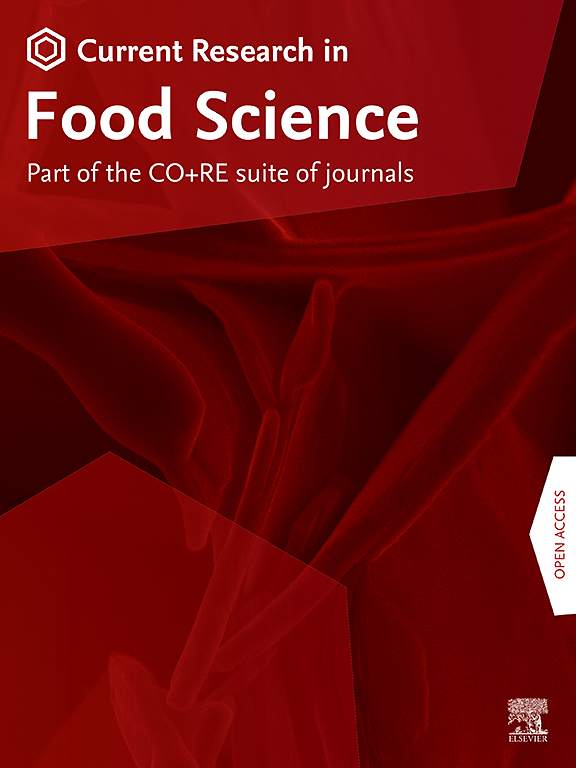Defatted chia (Salvia hispanica L.) flour peptides: Exploring nutritional profiles, techno-functional and bio-functional properties, and future directions
IF 7
2区 农林科学
Q1 FOOD SCIENCE & TECHNOLOGY
引用次数: 0
Abstract
Chia (Salvia hispanica L.) is a summer-blooming herb from the mint family, known for its rich nutritional profile, including high-quality protein, fibre, and a balanced ratio of omega-3 and omega-6 fatty acids. With the rising demand for chia oil, defatted chia flour (DCF), a by-product of oil extraction, has gained attention as a valuable ingredient. DCF is rich in essential macronutrients and amino acids, offering a sustainable alternative to traditional protein sources and supporting global food sustainability and waste reduction efforts. Recent studies have highlighted the techno-functional properties of DCF peptides, showing excellent solubility, water- and oil-absorption capacities, as well as emulsifying, foaming, and gelling abilities. These properties enhance their application in diverse food systems, making DCF an important ingredient in the development of nutritious, innovative, and appealing food products. Beyond their functional roles, chia-derived peptides also exhibit significant bioactive properties, such as antioxidants, antihypertensive, anti-inflammatory, neuroprotective, antidiabetic, antimicrobial, anti-aging, hypolipidemic, and hypoglycaemic effects. These properties make them beneficial for improving health and wellness. Integrating DCF peptides into food products provides a natural approach to managing chronic diseases, promoting longevity, and improving overall health. To fully realize the potential of DCF peptides, future research should focus on understanding their bioactivities at the molecular level and exploring how they interact with various physiological systems. Interdisciplinary collaboration among food science, biotechnology, pharmacology, and nutrition is essential, along with careful evaluation of safety and potential risks. Regulatory frameworks will be crucial for the broader use of DCF peptides in food and nutraceuticals. Additionally, advancements in peptide production, extraction, and purification technologies will be necessary for large-scale, sustainable applications. Focusing on these areas will maximize the benefits of chia peptides for human health, nutrition, and environmental sustainability.

脱脂鼠尾草(Salvia hispanica L.)面粉多肽:探讨营养特性、技术功能和生物功能特性及未来发展方向
鼠尾草(Salvia hispanica L.)是薄荷科的一种夏季盛开的草本植物,以其丰富的营养成分而闻名,包括高质量的蛋白质、纤维和平衡比例的omega-3和omega-6脂肪酸。随着人们对奇亚籽油需求的增加,脱脂奇亚籽粉作为一种有价值的原料受到了人们的关注。DCF富含必需的宏量营养素和氨基酸,是传统蛋白质来源的可持续替代品,并支持全球粮食可持续性和减少废物的努力。最近的研究强调了DCF肽的技术功能特性,显示出优异的溶解度,吸水和吸油能力,以及乳化,发泡和胶凝能力。这些特性增强了它们在各种食品系统中的应用,使DCF成为开发有营养、创新和有吸引力的食品的重要成分。除了它们的功能作用外,奇亚肽还具有显著的生物活性,如抗氧化剂、降压、抗炎、神经保护、抗糖尿病、抗菌、抗衰老、降血脂和降糖作用。这些特性使它们对增进健康和身心健康有益。将DCF肽整合到食品中为控制慢性疾病、延长寿命和改善整体健康提供了一种自然的方法。为了充分发挥DCF肽的潜力,未来的研究应侧重于在分子水平上了解其生物活性,并探索其与各种生理系统的相互作用。食品科学、生物技术、药理学和营养学之间的跨学科合作至关重要,同时还要仔细评估安全性和潜在风险。监管框架对于DCF肽在食品和保健品中的广泛应用至关重要。此外,肽生产、提取和纯化技术的进步将是大规模、可持续应用的必要条件。关注这些领域将最大限度地发挥奇亚肽对人类健康、营养和环境可持续性的益处。
本文章由计算机程序翻译,如有差异,请以英文原文为准。
求助全文
约1分钟内获得全文
求助全文
来源期刊

Current Research in Food Science
Agricultural and Biological Sciences-Food Science
CiteScore
7.40
自引率
3.20%
发文量
232
审稿时长
84 days
期刊介绍:
Current Research in Food Science is an international peer-reviewed journal dedicated to advancing the breadth of knowledge in the field of food science. It serves as a platform for publishing original research articles and short communications that encompass a wide array of topics, including food chemistry, physics, microbiology, nutrition, nutraceuticals, process and package engineering, materials science, food sustainability, and food security. By covering these diverse areas, the journal aims to provide a comprehensive source of the latest scientific findings and technological advancements that are shaping the future of the food industry. The journal's scope is designed to address the multidisciplinary nature of food science, reflecting its commitment to promoting innovation and ensuring the safety and quality of the food supply.
 求助内容:
求助内容: 应助结果提醒方式:
应助结果提醒方式:


